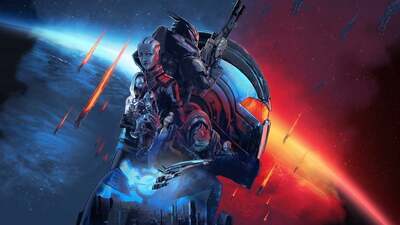Mass Effect Legendary Edition Gets the Squad Back Together

BioWare’s “Mass Effect” changed the video game landscape when it was released in 2007 exclusively for the Xbox 360. A sci-fi saga, the game blended role-playing elements with a level of shooter action not typically seen in the genre and gamers were hooked. The sequel, 2010’s “Mass Effect 2” made an even greater impact when it hit Windows and Xbox in 2010 and then really took off further when it was released for the PS3 in 2011. A masterpiece of a game, it’s widely considered one of the best releases of the 2010s. Building on the story of the first release, it wasn’t just a sequel that repeated what worked about the first title—it expanded a universe. And that universe felt personal and emotional to hardcore fans, leading to high expectations for 2012’s “Mass Effect 3,” a truly fantastic game in terms of gameplay but one that includes some storytelling decisions that frustrated fans of the series, especially in the final scenes. As quickly as “Mass Effect” exploded into pop culture, it felt like it burned out. 2017’s “Mass Effect: Andromeda” was a disappointment, but there remained enough love for the series that when a new game was announced in late 2020, people went crazy. A fifth “Mass Effect” game could easily bring back this juggernaut of a franchise, and the just-released “Mass Effect Legendary Edition” proves why.
The Legendary Edition includes all three of the main series games and, notably, all of their DLC (with the exception of one from the first game), incorporated into the main story in a way that’s typically seamless. When these games were released, they were often followed by new missions released as downloadable content, but now these additional chapters have been incorporated from the beginning, almost like a director’s cut of a feature film. All three games have been upgraded for the PS4 generation—it’s a bit too bad that they haven’t been more refined for the PS5 but we’re in that gray area between consoles so be patient—but it’s the first game with the most notable differences, visual changes that make it feel more of a piece with the other two. Even some of the mechanics and gameplay in the first game have been changed, making it the one to really experience in a new way. Several of the gameplay elements—like not being able to run and shoot at the same time—will still feel incredibly dated, but a lot of fans of this franchise jumped on-board in chapter two, and so it’s nice to see where it all began.

What’s “Mass Effect” about and how does it intersect with film culture? It’s the story of Commander Shepard—who can be John or Jane, depending on your preference—a soldier in the 22nd century. The story’s strongest non-game influence is probably “Star Trek” and all the films and shows inspired by the Enterprise’s journeys to the final frontier, but there’s, of course, a strong Lucasfilm brand here too. Some have even called the series the “Star Wars” of the gaming universe. Consider this like the “original trilogy.”
When I think of “Mass Effect,” I think of a squad, which was one of the many things that distinguished it from the “hero” structure of gaming in the ‘90s and ‘00s. Shepard is the lead, but there’s a strong collaborative sense to the “Mass Effect” experience in that you form a squad of allies with different strengths, skills, and equipment, choosing how to utilize them in the middle of combat. There are also dialogue trees that allow you to shape your relationships with your squad, even romantically. It created a game that amplified the authorship of the sci-fi/action experience. It wasn’t just a game about saving the universe, it was one about allies and teammates, and each game in the series deepened relationships and mechanics, making the trilogy such a dense, rewarding experience.

As for updates for the PS4 generation, most of them are in the first game, and they’re major and minor. The visual updates are noticeable (and guided by the original art director, Derek Watts), but there are incredibly detailed adjustments as well, including things as simple as faster elevators since the load time doesn’t need to be disguised for quite as long, or boss encounters that have been adjusted in terms of difficulty (under the guidance of one of the game’s original level designers). On a major level, there’s a dedicated melee button now, cover and aim mechanics are smoother, your squad is smarter, etc.—all facets that bring the game more in line with the second two releases, even if it still feels a little older than a 2021 title. There are improvements throughout the entire trilogy, including texture resolution across all three games and even some camera angle changes, but it’s the first “Mass Effect” that will feel the most updated.
Who should buy “Mass Effect Legendary Edition”? Hardcore fans of the trilogy probably already have it, and those who have never played these games should consider it a must-buy. But what if you’re one of the many who have played these games before but don’t know them by heart? It’s still worth a trip, and not just because of the incredible value of getting three games for one. It reminded me of how ambitious and detailed these games were, displaying a level of creative depth that we don’t often get for three games in a row in any franchise. Most of all, it made me hope that whatever BioWare is developing to bring this world back for the PS5 generation lives up to the high standard of what they did so many years ago.





